Next Generation
Deneb IV

Deneb IV (TNG-101-102)
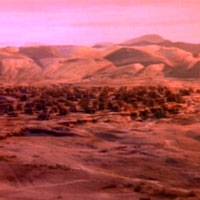
Bandi City (TNG-101-102)

Bandi City (TNG-101-102)
Class M planet and site of Farpoint Station, built and offered by the native humanoids, the Bandi, as a starbase for the United Federation of Planets. Its interior heat provided geothermal energy tapped as a power source, but not enough to have helped build the station as quickly as it had been.[2] It was known as an R&R spot for Starfleet personnel for more than a century,[1] but could still be described as being on the edge of the great unexplored part of the galaxy in 2363.[2]
References
- [1]TOS-01: Where No Man Has Gone Before
- [1]TNG-101-102: Encounter at Farpoint
Delphi Ardu System

Delphi Ardu (TNG-107)
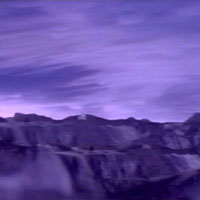
Delphi Ardu Surface (TNG-107)
Name of a star system with 11 planets, unexplored as of 2363, one of which became the site of the first direct Federation–Ferengi contact initiated by the U.S.S. Enterprise NCC-1701-D on Stardate 41386.4. Class-M but with no sign of native lifeforms, according to previous long-range scans, it was found to be one of several defensive outpost planets of the long-extinct Tkon Empire. Its force field, energy-draining weapon, and automated “guardian” were, amazingly, still functional.[1]
References
Delos System
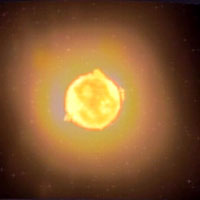
Delos (TNG-123)
Common name for at least two different star systems. One, long well-known in Federation circles, was home to a medical facility on its fourth planet, where Beverly Crusher interned in 2352.[2] Another more distant system included a yellow star with at least four planets, undergoing unusually large-scale magnetic field changes with accompanying solar flares circa Stardate 41650. Picard‘s crew visited the inhabited Ornara and Brekka in 2364, 200 years after the last contact by a Federation scout ship; one was on the verge of space flight, but neither had advanced much beyond that stage.[1]
References
Daled IV
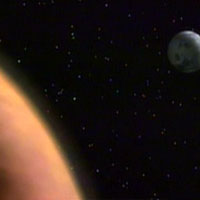
Daled IV (TNG-136)
A planet inhabited by two factions of allasomorphs divided by civil war throughout their recorded history. The planet was locked in synchronous rotation—one rotation for each revolution around the Daled star—and the resultant all-night/all-day hemispheric split gave rise to the two disparate cultures. A child, Salia, was born of parents from both sides and spirited away soon after their deaths so she could be raised in safe seclusion and return at age 16 in hopes of bringing peace to the planet. The world had no formal contact with the Federation, but Starfleet ships served as Salia’s courier both ways. Daled IV also had at least three moons, the third an inhabited Class-D world.[1]
References
Planet, Class-O
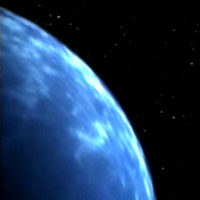
Pacifica (TNG-145)

Class-O Planet (ENT-56)
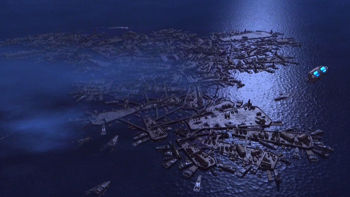
Class-O Planet Surface (ENT-56)
Pelagic. Age ranged from 3-10 billion years. Diameter was 10,000 to 15,000 km. Typically located in the Ecosphere of a planetary system. Liquid water covered 80% or more of the surface area, atmosphere consisted of nitrogen, oxygen, and trace elements. May have contained aquatic vegetation, animal life, and possibly humanoids.[1]
References
- 1. Star Trek: Star Charts. Book. 2002. Pocket Books.
Planet, Class-M

Earth (ENT-78)
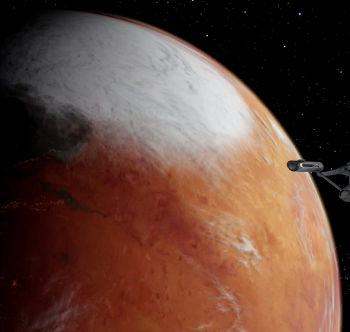
Vulcan (TOS-34)
Terrestrial. Age ranged from 3-10 billion years. Diameter was 10,000 to 15,000 km. Typically located in the Ecosphere of a planetary system. Surface water was abundant; if water or ice covered more than 80% of the surface, the planet was considered Class O or Class P. Atmosphere was primarily primarily nitrogen, oxygen, and trace elements. Contained extensive vegitation and animal life.[8] Capable of supporting carbon-based, humanoid life.[1]
The designation apparently stemmed from the Vulcan word “Minshara,” which was used to designate planets capable of supporting life.[7] Class-M planets could vary widely in color, cloud cover, and overall appearance. Most Class-M planets were characterized by a relatively thin, tectonically active crust floating on a molten rock mantle, which in turn surrounded a liquid metal outer core and a solid inner core composed of metal crystals.
› Continue reading
Planet, Class-L
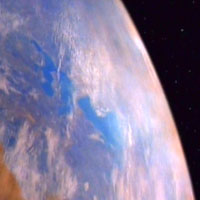
Indri VIII (TNG-246)
Marginal. Age ranged from 4-10 billion years. Diameter was 10,000 to 15,000 km. Typically located in the Ecosphere of a planetary system. Surface was rocky and barren, with little surface water; atmosphere was oxygen/argon, with a high concentration of carbon dioxide. Suitable for humanoid colonization. Typically had limited plant life.[1]
Class-L Planets
References
- 1. “The Chase.” Star Trek: The Next Generation, Episode 246. Television. 26 April 1993.
- 2. Star Trek: Star Charts. Book. Pocket Books. October 2002.
Planet, Class-K
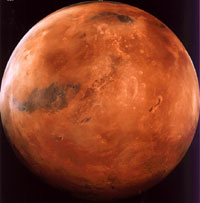
Mars (STSC)

Mudd (TOS-41)
Adaptable. Age ranged from 4-10 billion years. Diameter was 5000 to 10,000 km. Typically located in the Ecosphere of a planetary system. Surface was barren, with little or no surface water, atmosphere was thin and mostly carbon dioxide. Adaptable for humanoid colonization through the use of pressure domes and terraforming. May contain primitive single-celled organisms.[1]
Class-K Planets:
References
Planet, Class-J
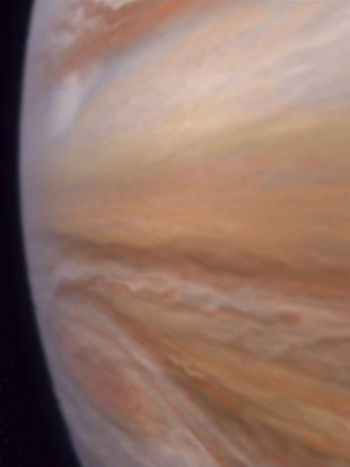
Jupiter (ENT-50)
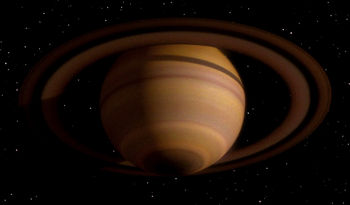
Saturn (TNG-101-102)
Gas giant. Age ranges from 2-10 billion years. Diameter is 50,000 to 140,000 km. Typically located in the Cold Zone of a planetary system. Surface radiates some heat and is tenuous and comprised of gaseous hydrogen and hydrogen compounds, atmospheric zones vary in temperature, pressure and composition. May contain hydrocarbon-based life forms.[1]
References
- 1. Star Trek Star Charts. Book. Pocket Books. October 2002.
Categories
- Animated Series (60)
- Articles (28)
- Books (447)
- Cast & Crew (79)
- Comics (22)
- DS9 (328)
- Early Voyages (125)
- Education (5)
- Enterprise (373)
- Excelsior (36)
- Food (19)
- Games (223)
- Klingon (70)
- Library (1,543)
- Logs (593)
- Lost Era (55)
- Medicine (18)
- Merrimac (1)
- Mirror (35)
- Miscellaneous (13)
- New Frontier (54)
- Next Generation (635)
- Original Series (681)
- Personnel (436)
- Places (369)
- Politics (12)
- Recreation (10)
- SCE (41)
- Science (1)
- Shatnerverse (9)
- Ships (455)
- Site Updates (98)
- Starfleet Academy (86)
- Stargazer (42)
- STO (61)
- Technology (45)
- Titan (59)
- To Boldly Go (1)
- TV/Film (214)
- Uncategorized (4)
- Vanguard (76)
- Voyager (236)
- Weapons (27)
- Xenology (54)